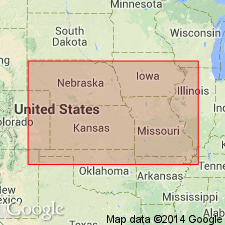
- Usage in publication:
-
- Elm Branch shale
- Modifications:
-
- Areal extent
Summary:
Pg. 99, 101, 103. Elm Branch shale will be proposed by Newell to include strata overlying Sniabar limestone and underlying Middle Creek limestone. Where these limiting limestones are present in Kansas the thickness ranges from about 5 to 12 feet and it contains local beds of limestone less than 1 foot thick. Age is Late Pennsylvanian (Missouri age).
[Origin of name not stated.]
Source: US geologic names lexicon (USGS Bull. 896, p. 638).
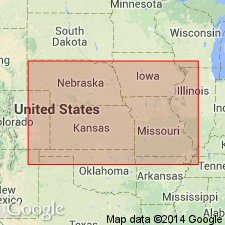
- Usage in publication:
-
- Elm Branch shale member
- Modifications:
-
- Original reference
- Dominant lithology:
-
- Shale
Summary:
Pg. 85, 90, 97. Elm Branch shale member of Swope formation of Bronson group. [See under Swope formation.] Named by N.D. Newell. Age is Late Pennsylvanian (Missouri age).
Source: US geologic names lexicon (USGS Bull. 896, p. 638); GNC KS-NE Pennsylvanian Corr. Chart, sheet 2, Oct. 1936.
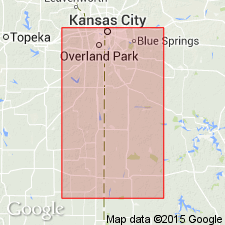
- Usage in publication:
-
- Elm Branch shale
- Modifications:
-
- Areal extent
Summary:
Pg. 117. Used Elm Branch shale for beds underlying Middle Creek limestone and overlying Sniabar limestone; as did R.C. Moore and G.E. Condra in their Oct. 1932 revised classification of Pennsylvanian of Kansas and Nebraska, and J.M. Jewett (Kansas Acad. Sci. Trans., v. 36, 1933, p. 132). Age is Late Pennsylvanian (Missouri age).
Source: US geologic names lexicon (USGS Bull. 896, p. 638).
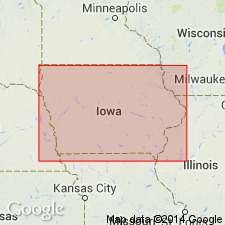
- Usage in publication:
-
- Elm Branch shale
- Modifications:
-
- Areal extent
- AAPG geologic province:
-
- Iowa shelf
Summary:
Pg. 7. In Madison County, Iowa, Elm Branch shale underlies Middle Creek limestone, overlies Sniabar ("Hertha") limestone, and consists of (descending): (1) gray calcareous chale, fossiliferous at top, 1 foot 10 inches; (2) limestone-mudstone, dark gray, probably not persistent, 1+ foot; (3) gray argillaceous shale, 4 feet; (4) limestone-mudstone, dark gray, uneven, 1 foot 3 inches; (5) gray shale with poorly defined reddish subzone near base, 6+/- feet. Age is Pennsylvanian.
[Origin of name not stated.]
Source: US geologic names lexicon (USGS Bull. 896, p. 638).
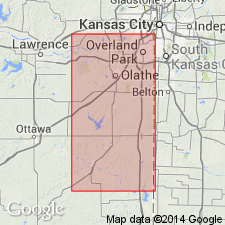
- Usage in publication:
-
- Elm Branch shale
- Modifications:
-
- Not used
Summary:
Pg. 19. †Elm Branch shale. Called the shale underlying Middle Creek limestone and overlying Hertha (Sniabar) limestone the Ladore shale, and apparently discarded Elm Branch shale.
Source: US geologic names lexicon (USGS Bull. 896, p. 638); GNC KS-NE Pennsylvanian Corr. Chart, sheet 2, Oct. 1936.

- Usage in publication:
-
- Elm Branch shale†
- Modifications:
-
- Abandoned
Summary:
Pg. 82. Formally discarded †Elm Branch shale.
Source: US geologic names lexicon (USGS Bull. 896, p. 638); GNC KS-NE Pennsylvanian Corr. Chart, sheet 2, Oct. 1936.
For more information, please contact Nancy Stamm, Geologic Names Committee Secretary.
Asterisk (*) indicates published by U.S. Geological Survey authors.
"No current usage" (†) implies that a name has been abandoned or has fallen into disuse. Former usage and, if known, replacement name given in parentheses ( ).
Slash (/) indicates name conflicts with nomenclatural guidelines (CSN, 1933; ACSN, 1961, 1970; NACSN, 1983, 2005, 2021). May be explained within brackets ([ ]).

